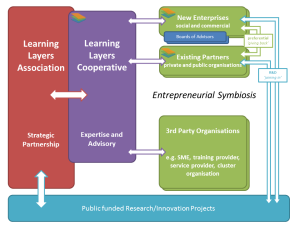LL Consortium meeting in Innsbruck – Part Three: Presenting exploitation initiatives
Last week our EU-funded Learning Layers (LL) project had its consortium meeting in Innsbruck. In the previous posts I discussed firstly the ‘warm-up’ event with Austrian clusters/ networks and secondly our project meeting and its general results. In this post I will discuss the results of the exploitation sessions (presentations and bilateral talks).
1. The setup of the exploitation sessions
As I had indicated in the previous post, we had firstly a general introduction to the exploitation model that served as a reference model. We also agreed to work towards a jointly agreed ‘exploitation manifesto’ that helps us to settle the IPR issues. With this preparation the partners were invited to present their exploitation plans and/or intentions. A major part of the session was dedicated to the presentations of partners (or groups of partners), altogether 15. Then, on the next day we had a special session for bilateral or trilateral ‘matchmaking talks’ (on the basis of expressions of interests indicated during the first session).
2. Contributions of the Construction sector partners
2a) The presentation of ITB/Pont (Bremen) & Bau-ABC teams highlighted firstly some key questions for the LL project and then a further challenge for follow-up activities. It also gave an overview on tools and services developed so far. Based on this background the presentation drew then attention to two kinds of emerging R&D projects:
- The DigiProB project as a spin-off from LL in the context of Continuing Vocational Training (CVT). The technical challenge is to reuse/repurpose an integrative toolset to support Personal Learning Environments of CVT participants. The social challenge is to support individual learners (who are learning alongside work) with the aim to demonstrate with work-related projects that they have acquired higher (managerial) qualifications in construction sector.
- The “Bauen 4.0” has been selected as a recognised cluster initiative and is invited to submit specific project proposals. One of the initiatives discussed in the cluster meetings is a project for incorporating know-how on Building Information Modelling (BIM) to the CVT schemes for advanced construction craftsmen in carpentry and woodwork (Holzbau). Here we see a chance to make use of LL tools.
Alongside these examples we presented two cases in which the integrative toolset Learning Toolbox can be brought into collaboration and exchanges with third party software/services (who were affiliated with construction sector stakeholders).
- Pontydysgu had been contacted by Construction Excellence Wales, Construction Industry Training Board and a consortium of four FE colleges with interests in the Learning Toolbox. In particular there was an interest to link the LTB with the e-learning environment that had been developed by the FE colleges for construction sector apprentices.
- Bau-ABC had been contacted by a new company that continues the prior work of a company that had been producing handbooks for well-builders. The new company focuses on developing mobile apps and digital contents. This company will launch its products during February 2016 and is already making contacts with key players in domain-specific education and training.
2b) The presentation of Bau-ABC: The Bau-ABC team had prepared a separate presentation in which they brought forward their interests in further development and promotion of LTB. In this respect the presentation summarised the immediate benefits for individual users (urgencies for developers), the benefits for Bau-ABC as training provider and multiplier and the prospects for cooperation between Bau-ABC and the developers of LTB and related LL tools and services. In this way Bau-ABC outlined the working perspectives with which it positions itself on the “Exploitation map” to be drawn later.
3. The bilateral talks
After the presentation session our requests for bilateral talks with other presenters (with eventual topics to be discussed) were collected. Then a similar ‘world café’ session was organised as in the warm-up event. We had four tables for rotation but this time no fixed ‘table hosts’. Instead, we were rotating with uneven opportunities for the talks. In some sessions we participated as wider groups, in some sessions as individuals. At some point we were interrupted by fire alarm and the whole building was evacuated to an outdoor meeting point. (The fire was put out promptly, the fire brigade just needed to check the situation and that the smoke was properly ventilated. Yet, this all took that much time that we couldn’t properly complete the session.)
At this point it is not necessary to report on all bilateral talks in which I/we were involved. Some of them focused on very specific questions and very particular interests. Some were talks on emerging ideas for future projects that need further conversations. In addition – due to the interruption – we didn’t have a chance for some talks that we had on our list. Therefore, it have prepared a list of topics for further talks to be continued at a later date:
- ‘Cross-sectoral’ talks on the uses of LTB (and other LL tools) taking into account prior work with nurse education and nurse education networks in Germany and England.
- ‘Cross-institutional’ talks on the use of LTB and other LL tools/services to support problem-, project- and practice-based learning in vocational education and training (VET) and/or Vocational Higher Education (notably in Germany, Estonia and Austria).
- ‘Cross-curricular’ talks on the use of LTB and other LL tools in the activities of vocational teacher education/ training the trainers (notably in Germany and in Austria, e.g. the partners of the pre-event).
- ‘Sustainability’ talks with LTB developers on their new organisational initiative and the role of R&D initiatives.
- ‘Scalability’ talks on the experience with the ‘Theme Room’ training in Bau-ABC to adapt the approach for multiplier activities. (These talks will be based on the involvement of the initial contributors and other interested parties).
I think this is enough of these sessions. Due to our tight schedules we couldn’t be present in the final sessions of the meeting. But we are sure that there results will be discussed in several follow-up meetings. Given, that we are entering an intensive period of fieldwork, we need to keep the exploitation issues on our agendas.
More blogs to come …

